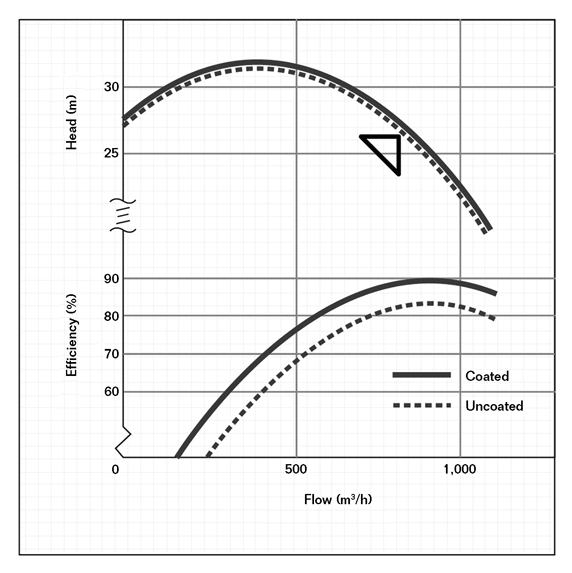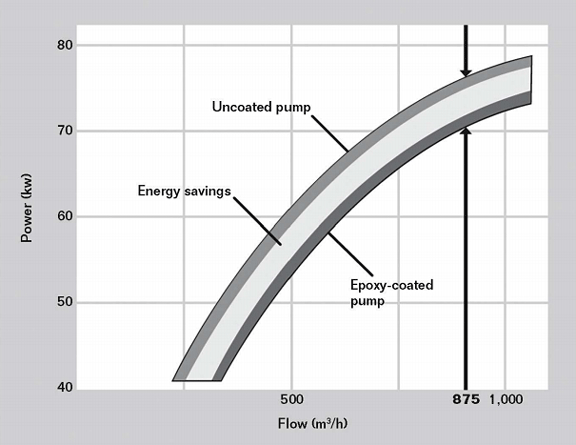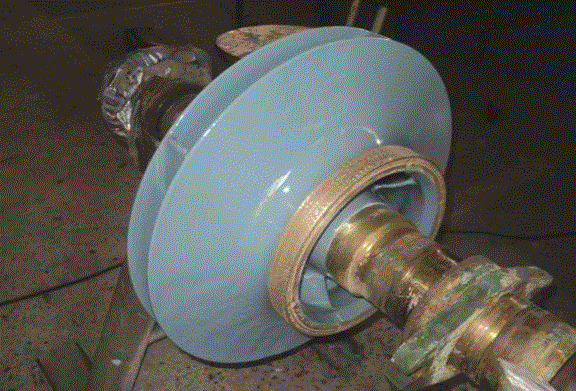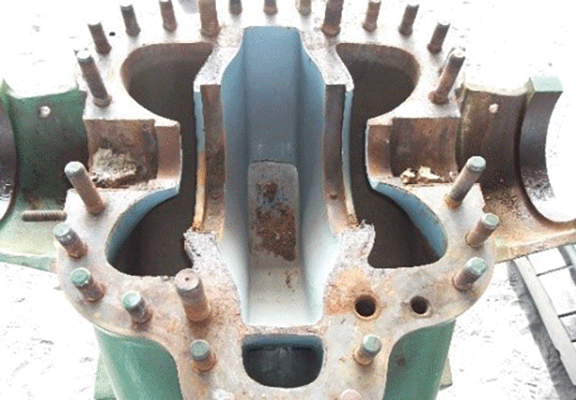Editor’s note: Learn more about cavitation erosion-corrosion in this
Materials Performance quarterly special feature, “The Science Behind It.” Read the
MP article on linings that protect against erosion-corrosion, then explore the science behind the corrosion problem, which is presented in several related
CORROSION articles listed at the end of the article.
The purpose of water treatment is to purify drinking water to meet government regulations for quality and produce wastewater effluent that has a reduced impact on the environment. Water and wastewater treatment plants (WWTPs) employ various stages to accelerate the natural processes that purify water and wastes. Whatever methods, equipment, or technologies are used, pumps are an essential component for moving raw water, waste water, sludge, and effluent within different processes. With high global demands for energy, the industry is looking for pumping systems that maximize efficiency, reliability, and cost-effectiveness.
Reductions in pump efficiency can be caused by mechanical, volumetric, and hydraulic losses. Mechanical loss is related to moving components of a pump, such as bearings and glands. Volumetric loss refers to leakage of fluid from the discharge side of the pump to the suction side. Hydraulic loss is caused by the frictional forces created between the fluid and the walls of the hydraulic passage, acceleration, and the change of the fluid direction.1 Therefore, smooth pump walls reduce flow fluctuations and, subsequently, the energy required for the pump to move the fluid.2 This article discusses the use of state-of-the-art lining technologies to increase the efficiency of pumps while protecting their internal surfaces from erosion and corrosion.
Effect of Pump Surface Roughness
The two categories of pumps most commonly used at WWTPs are the centrifugal and positive displacement pumps.3 Centrifugal pumps are more common because they are simple and safe to operate under a broad range of conditions.4 The operating principle of moving a fluid by means of mechanical actions can be detrimental to the internal components of the pump. For example, centrifugal pumps are susceptible to damage and performance degradation by cavitation, where vapor bubbles form in the low-pressure region directly behind the rotating impeller vanes. The collapse of these bubbles can damage the impeller and erode the pump casing.5 Pressure drop control in pumps is often limited, and cavitation cannot be avoided. Over time, cavitation can create severe erosion-corrosion problems.4
The roughness of pump surfaces affects the fluid flow. As the roughness increases, the laminar flow becomes unstable and transitions into turbulent flow. Erosion-corrosion mechanisms are exacerbated under turbulent flow conditions. Surface defects in the form of small protrusions or depressions, such as corrosion pits, deposits, and weld beads, can cause disturbed flow on a smaller scale. Although small, such defects are sufficient to initiate the erosion-corrosion processes in the form of impingement, cavitation, and even entrainment in the presence of solid particles.6 Under these circumstances, energy losses will occur and lead to further reduction in efficiency of the pumping system.4
Alternatives for Pump Efficiency Improvements
Traditional solutions to mitigate the adverse consequences of turbulent flow regimes include equipment design modifications to reduce hydrodynamic forces and the use of exotic, erosion-resistant alloys as materials of construction.7 However, due to cost, ease of construction, and availability, the materials of construction most commonly chosen are cast iron, carbon steel (CS), or stainless steel (SS). The resistance of these conventional materials to corrosion and erosion is relatively low; and in the case of SS, localized corrosion can still occur when its protective passivation film is damaged or exposed to chloride environments.
Another way to reduce erosion-corrosion and improve efficiency is to isolate the metal surface from its contact environment with a lining. Several benefits of this alternative can be cited:8
1. Lining pumps fabricated of CS with fit-for-service coatings provides a cost-effective method of improving the corrosion resistance of conventional materials when compared to the use of corrosion-resistant alloys or cladding.
2. Lining materials are readily available if needed, even at short notice.
3. Lining materials do not add significant weight to the pumps. In some cases, linings can facilitate a decrease in weight because of a reduced corrosion allowance for the metal based on lower anticipated erosion and corrosion rates.
4. Efficient lining application methods allow for shorter project lead times and less equipment downtime.
A wide range of corrosion-resistant coating technologies can be employed for protecting the interiors of pumps. Some of them include glass flake, thermosetting polyurethane, and nonsolvent-free epoxy coatings. The use of some of these coatings is limited by the presence of volatile organic compounds (VOCs) in their composition, which may cause health and safety problems. Others have poor mechanical adhesion and reduced resistance to erosion and corrosion. Due to technological advances in protective industrial linings and repair composite materials, it is now possible to use polymeric materials for coating systems with outstanding resistance to erosion-corrosion and cavitation. These high-technology linings can effectively enhance pump performance.
Coatings Designed with a Unique Combination of Properties
 State-of-the-art coating technology has resulted in coatings with unique chemistry. Improved erosion-corrosion resistance, hydrophobicity, and hydraulic smoothness are characteristics that enable high energy efficiency and optimal pump performance to be achieved. These coatings are essentially formulated as a blend of lubricant agents and abrasion-resistant fillers. The fillers are used to reduce erosion-corrosion wear, whereas a blend of different amines provides a smooth finish and low electronic affinity toward water molecules. As a result, the onset of turbulent flow is delayed, which consequently reduces skin friction.2
State-of-the-art coating technology has resulted in coatings with unique chemistry. Improved erosion-corrosion resistance, hydrophobicity, and hydraulic smoothness are characteristics that enable high energy efficiency and optimal pump performance to be achieved. These coatings are essentially formulated as a blend of lubricant agents and abrasion-resistant fillers. The fillers are used to reduce erosion-corrosion wear, whereas a blend of different amines provides a smooth finish and low electronic affinity toward water molecules. As a result, the onset of turbulent flow is delayed, which consequently reduces skin friction.2
These coatings are solvent-free, epoxy-based, and free of VOCs so health and safety concerns are reduced and product shrinkage is avoided. Coating systems can be applied in relatively thin layers to circumvent any flow restriction problems. Linings have been reported with a surface roughness of 0.09 µm vs. 1.19 µm for polished SS. The ultra-smooth surface, as well as self-levelling and hydrophobic properties, lessen turbulence and surface tension.
These high-performance coatings were tested for service fitness in alignment with internationally recognized methodologies such as those provided by ISO, NACE International, and ASTM. Such coatings have reported adhesion values greater than 31 MPa (4,500 psi) on grit-blasted mild steel when tested in accordance with ASTM D45419 and ISO 4624.10 Atlas cell testing, in accordance with NACE TM0174,11 is also used to determine the suitability of these coatings in immersion service. Chemical testing using ISO 2812-112 is another test required for assessing the resistance of coatings to the range of chemicals found in the WWTP. Some of these chemicals include chlorine, ferric chloride (FeCl3), and sodium hypochlorite (NaClO).
Additionally, these protective coatings can be tested for potable water contact in agreement with the U.K. Drinking Water Inspectorate (London, United Kingdom) and NSF/ANSI 61 requirements.13
Pump Efficiency
The performance of a centrifugal pump is typically described by a graph that plots the pressure generated by the pump over a range of flow rates (measured in terms of head). Also, its efficiency is included on a typical pump performance curve. The efficiency of a pump is the ratio of the pump’s fluid power to the pump shaft power. A centrifugal pump has a best efficiency point (BEP) where it operates the most cost-effectively in terms of both energy efficiency and maintenance. Continuously operating a pump at its BEP is difficult because systems usually have changing demands.4
 A pump performance test in 1989—conducted by the National Engineering Laboratory (then part of the United Kingdom’s Department of Trade and Industry), an international reference in fluid flow testing that represents the most comprehensive pump test facilities worldwide—identified efficiency enhancement of a centrifugal pump that was lined.14 The tests were carried out in a single stage, end-suction centrifugal pump with 10-in (254-mm) suction and discharge branches. The pump (in an uncoated condition) ran at 1,300 rpm, had a capacity of 875 m3/h (5.55 millions of gallons per day [mgd]) at 26.5 m head, and overall peak efficiency of 83.5%.14 The same pump was then protected with a lining to demonstrate that enhanced pump efficiency could be achieved.
A pump performance test in 1989—conducted by the National Engineering Laboratory (then part of the United Kingdom’s Department of Trade and Industry), an international reference in fluid flow testing that represents the most comprehensive pump test facilities worldwide—identified efficiency enhancement of a centrifugal pump that was lined.14 The tests were carried out in a single stage, end-suction centrifugal pump with 10-in (254-mm) suction and discharge branches. The pump (in an uncoated condition) ran at 1,300 rpm, had a capacity of 875 m3/h (5.55 millions of gallons per day [mgd]) at 26.5 m head, and overall peak efficiency of 83.5%.14 The same pump was then protected with a lining to demonstrate that enhanced pump efficiency could be achieved.
The coating assessed was a solvent-free, two-component epoxy system, specially designed for improving the efficiency of fluid-handling equipment and protecting metal surfaces from the effects of erosion-corrosion. This coating was applied in two colors to confirm the second coat had been uniformly applied and entirely covered the first coat, and to make future inspections easier to evaluate. The two pump tests were carried out in a typical closed-loop system using the same protocol, with a series of flow, head, and power readings taken across a wide flow range. The pump efficiency curve, developed with calibrated test instrumentation and traceable to national standards, was then plotted (Figure 1).

Testing results of the coated pump indicated a 6% increase at peak efficiency (Figure 1). Significantly, there was little change to the pump head/flow characteristics, meaning the coating increased the pump efficiency while maintaining the original head/flow properties. The power reduction of 5.1 kWh was achieved at duty point (Figure 2).14
Case History
A state government water and wastewater treatment company in Bahia, Brazil employed a lining to protect a centrifugal pump and increase its efficiency. This water and wastewater company is responsible for operating and maintaining 431 water treatment systems and 94 wastewater plants across more than 360 municipalities in Bahia. The water treatment plants provide drinking water for 11.9 million people, whereas the wastewater plants provide sanitation to ~4.8 million people.15
 In 2006, the plant maintenance personnel of one of these plants detected anomalies in their process, mainly due to mechanisms of erosion-corrosion and cavitation in the pumping system. The asset, a Worthington† split-case centrifugal pump with a capacity of 1.080 m3/h (6.84 mgd), was installed in the pump system to capture raw water from the São Francisco River for treatment and delivery to the community. This pump was experiencing localized metal loss and corrosion, mostly in the volute casing and impeller (Figure 3). Several repair alternatives were considered by the asset owner. The decision was made to use a 100% solids epoxy-based lining to protect the damaged internal parts of the pump. The work was carried out by authorized applicators following the lining manufacturer’s product instructions for use, as follows:
In 2006, the plant maintenance personnel of one of these plants detected anomalies in their process, mainly due to mechanisms of erosion-corrosion and cavitation in the pumping system. The asset, a Worthington† split-case centrifugal pump with a capacity of 1.080 m3/h (6.84 mgd), was installed in the pump system to capture raw water from the São Francisco River for treatment and delivery to the community. This pump was experiencing localized metal loss and corrosion, mostly in the volute casing and impeller (Figure 3). Several repair alternatives were considered by the asset owner. The decision was made to use a 100% solids epoxy-based lining to protect the damaged internal parts of the pump. The work was carried out by authorized applicators following the lining manufacturer’s product instructions for use, as follows:
• The defective parts were abrasive blasted to achieve surface cleanliness requirements of NACE No. 2/SSPC-SP 1016 and ISO 8501-1 (Sa 2½),17 with a minimum average profile of 3 mils (75 µm).
• The surfaces were tested for salt contamination and treated accordingly.
• The surfaces were washed down with appropriate cleaner/degreaser to remove residual blasting debris and any grease contaminants.
• The thickness of the pump wall was restored according to the original equipment manufacturer’s pump repair guidelines using paste-grade epoxy materials.
• The protective coating was manually applied in two coats of contrasting colors to obtain a minimum total dry film thickness
• The lining was allowed to cure for chemical service (Figures 4 and 5) and further inspected for continuity.

Results
The pump was returned to service. After six years of continuous use, the pump was opened for inspection by maintenance personnel. Some erosion wear and metal loss from moderate cavitation could be seen on the volute surface (Figure 6), but the lining was in good condition. The plant managers were satisfied with the results. The pump had been protected against cavitation and corrosion for six years. The procedure is now part of their preventive maintenance program.
The pump also was tested to assess both the energy consumption and the cost of power consumption savings associated with operating a more efficient pump. Direct measurement of motor current was chosen to accurately evaluate improvement of the pump’s efficiency. Electric current readings were taken on the motor of an uncoated and coated pump under the same conditions. The readings for the uncoated pump showed an average of 72 A with 440 V, whereas readings reported an average of 66 A for the coated pump. The results showed an amperage reduction of 8.33% and a consequent reduction in the power consumption, since these variables are directly proportional.
These results demonstrated that this coating technology effectively contributed to decreasing losses by protecting the surface against the effects of erosion-corrosion and cavitation. Creating a smooth, hydrophobic finish also led to a reduction in energy consumption. Since then, the same efficiency-enhancing polymeric coating was applied to eight of the 12 pumps at that pump station. The results can be replicated for other types of pumps.

Conclusions
The polymeric coating technology proved to be an appropriate alternative for improving the performance of the pump, as well as protecting it from corrosion, with minimal maintenance work throughout its intended lifetime. The technology is recommended for protecting pump surfaces and enhancing pump efficiency within water and wastewater plants.
As expected, cavitation effects were not eradicated but minimized; however, the increase in fluid flow efficiency represented an immediate saving in power consumption, one of most significant operating expenses for water and wastewater treatment plants.
† Trade name.
References
1 M. Volk, Pump Characteristics and Applications, 2nd ed. (New York, NY: CRC Press, Taylor & Francis Group, 2005).
2 O. Oharriz, “Coatings Can Improve Submersible Pump Efficiency,” Power Engineering 8 (2009).
3 “Wastewater Technology Fact Sheet—In-Plant Pump Stations,” U. S. Environmental Protection Agency, EPA 832-F-00-069, 2000.
4 “Improving Pumping System Performance,” Lawrence Berkeley National Laboratory, U.S. Department of Energy, 2006.
5 P. Shinde, A. Satam, “Cavitation Effect in Centrifugal Pump,” Int. J. of Researchers, Scientists and Developers 2, 2 (2014).
6 J. Postlethwaite, S. Nešić, “Erosion-Corrosion in Single and Multiphase Flow,” Uhlig’s Corrosion Handbook, 2nd ed., W. Revie, ed. (Hoboken, NJ: John Wiley and Sons Inc., 2000).
7 J. Fan, J. Mazur, N. Melicharek, M. Schmittdiel, “Erosion, Cavitation, and Fretting Corrosion,” http://www.google.com/url?sa=t&rct=j&q=&esrc=s&source=web&cd=1&cad=rja&uact=8&ved=0ahUKEwjfw96uko_XAhVW0WMKHb0DBasQFggpMAA&url=http%3A%2F%2Fwww.lettsvankirk.com%2Findex.php%3Foption%3Dcom_docman%26task%3Ddoc_download%26gid%3D35%26Itemid%3D&usg=AOvVaw29kbZwJL2cKUpAepjXqFct (Oct. 26, 2017).
8 O. Oharriz, “Internal Corrosion Management of Process Vessels in the Oil and Gas Industry,” 2016 NACE Corrosion Risk Management Conference (Houston, TX: NACE International, 2016).
9 ASTM D4541-17, “Standard Test Method for Pull-Off Strength of Coatings Using Portable Adhesion Testers” (West Conshohocken, PA: ASTM, 2017).
10 ISO 4624:2016, “Paints and Varnishes—Pull-Off Test for Adhesion” (Geneva, Switzerland: ISO, 2016).
11 NACE TM0174-2002, “Laboratory Methods for the Evaluation of Protective Coatings and Lining Materials on Metallic Substrates in Immersion Service” (Houston, TX: NACE International, 2002).
12 ISO 2812-1:2017, “Paints and Varnishes—Determination of Resistance to Liquids—Part 1: Immersion in Liquids Other than Water” (Geneva, Switzerland: ISO, 2017).
13 NNSF/ANSI 61, “Drinking Water System Components—Health Effects” (Ann Arbor, MI: NSF International, 2016).
14 J. Maillard, “Coating Technology Increases Pump Performance,” Belzona International Ltd., 2008.
15 Embasa—Bahia State Water and Sanitation Co., “Areas of Expertise,” http://www.embasa.ba.gov.br/institucional/embasa/area_atuacao (Oct. 26, 2017).
16 NACE No. 2/SSPC-SP 10, “Near-White Metal Blast Cleaning” (Houston, TX: NACE).
17 ISO 8501-1:2007, “Preparation of Steel Substrates Before Application of Paints and Related Products—Visual Assessment of Surface Cleanliness—Part 1: Rust Grades and Preparation Grades of Uncoated Steel Substrates and of Steel Substrates After Overall Removal of Previous Coatings” (Geneva, Switzerland: ISO, 2007).